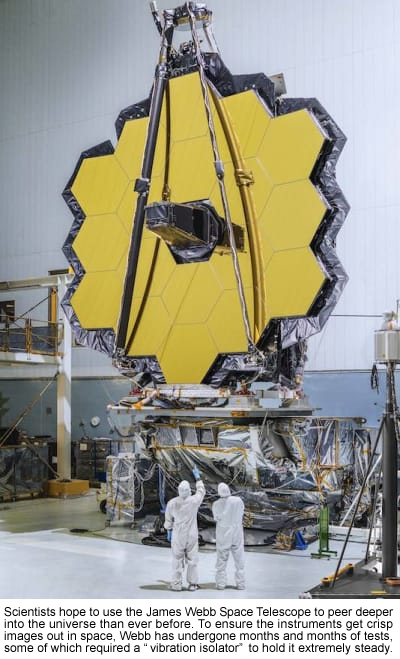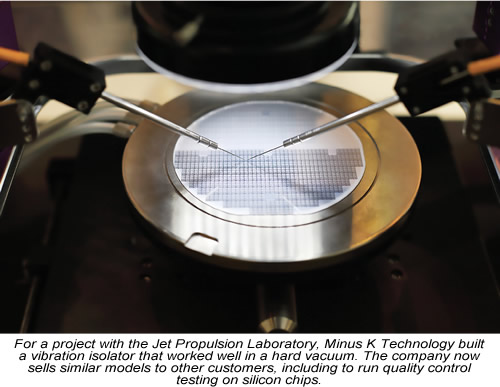
NASA Tech Briefs- January 2020
Vibration Isolator Steadies Optics for Telescopes
Isolators used to control semiconductor manufacturing keep the James Webb Space Telescope steady.
 Anybody who has ever tried to hold a camera steady for a long exposure in low light knows exactly what inevitably happens: the camera shakes, and the image blurs. The same can happen with images from telescopes or any other long-range image. In fact, for some very sensitive optics, even ordinary ground vibrations can be enough to throw off the results.
Anybody who has ever tried to hold a camera steady for a long exposure in low light knows exactly what inevitably happens: the camera shakes, and the image blurs. The same can happen with images from telescopes or any other long-range image. In fact, for some very sensitive optics, even ordinary ground vibrations can be enough to throw off the results.
That’s why NASA often needs a tool called a vibration isolator, explains Serge Dubovitsky, instrument system engineer at the Jet Propulsion Laboratory (JPL). These work in a few different ways but essentially create a more stable platform where external vibrations won’t interfere with sensitive measurements.
Dubovitsky often works on optics, including systems of mirrors for observational missions like telescopes. The mirrors reflect light in different wavelengths, concentrating it into an image that can be analyzed by other instruments. But before these optics are installed, they have to be tested to ensure they perform as intended. “For optics that operate in roughly visible wavelengths,” says Dubovitsky, “any motion on the scale of one micron [that is, one-millionth of a meter], or in some cases even much less than that, disturbs the image quality.”
Optics testing is also often done in a vacuum, with ramifications for vibration isolators. “Vacuum is important in verifying optics, because air interferes with light. If you are aiming at space applications, on the ground you need vacuum,” Dubovitsky explains. Even when working with optics that will remain on the ground, a vacuum can be helpful for testing
Vacuum creates its own challenges, though, especially for vibration isolators, which often use air to make the platform “float” and tend to include hoses and bladders made of rubber, which can outgas or leak, releasing lightweight molecules that could interfere with the vacuum. Air systems also have to be able to vent exhaust gases without compromising the vacuum. Other systems that use electricity risk overheating, because there is no airflow to help dissipate heat. Faced with a recent project that required an isolator for testing space-ready optics, which requires a fairly high degree of vacuum compared to typical industry standards, JPL turned to a company called Minus K Technology.
 NASA has bought several vibration isolators from Minus K over the years—including a system for the James Webb Space Telescope of six isolators, specially built to hold up to 10,000 pounds each. That’s a larger capacity than Minus K had ever built before, and, the company believes, the largest-capacity vibration isolator anywhere for this type of application. “Six of our isolators are now on top of a chamber at Johnson Space Center supporting that project,” says engineering director Erik Runge, adding that “now that we have the design, we could adapt it for other customers too.”
NASA has bought several vibration isolators from Minus K over the years—including a system for the James Webb Space Telescope of six isolators, specially built to hold up to 10,000 pounds each. That’s a larger capacity than Minus K had ever built before, and, the company believes, the largest-capacity vibration isolator anywhere for this type of application. “Six of our isolators are now on top of a chamber at Johnson Space Center supporting that project,” says engineering director Erik Runge, adding that “now that we have the design, we could adapt it for other customers too.”
The company had to test special greases and parts to find what would work best in a hard vacuum and not outgas. “As a result of some of the things we’ve learned, we can make all of our vacuum-compatible isolators to work at a higher level of vacuum, when needed,” Runge said.